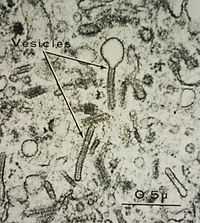Birbeck granules

Birbeck granules, also known as Birbeck bodies, are rod shaped[1] or "tennis-racket" cytoplasmic organelles with a central linear density and a striated appearance. They are a characteristic microscopic finding in Langerhans cell histiocytosis (Histiocytosis X), which is one of a group of rare conditions collectively known as histiocytosis.
Formation is induced by langerin.[2]
Function
Function is under question, but one theory is that they migrate to the periphery of the Langerhans cells and release its contents into the extracellular matrix. Another theory is that the Birbeck granule functions in receptor-mediated endocytosis, similar to clathrin-coated pits.
History
Birbeck granules were discovered by Michael Stanley Clive Birbeck (1925–2005), a British scientist and electron microscopist who worked at the Chester Beatty Cancer Research Institute or Institute of Cancer Research, London from 1950 until 1981.[3]
References
- ↑ Mc Dermott R, Ziylan U, Spehner D et al. (January 2002). "Birbeck granules are subdomains of endosomal recycling compartment in human epidermal Langerhans cells, which form where Langerin accumulates". Mol. Biol. Cell 13 (1): 317–35. doi:10.1091/mbc.01-06-0300. PMC 65091. PMID 11809842.
- ↑ Kissenpfennig A, Aït-Yahia S, Clair-Moninot V et al. (January 2005). "Disruption of the langerin/CD207 gene abolishes Birbeck granules without a marked loss of Langerhans cell function". Mol. Cell. Biol. 25 (1): 88–99. doi:10.1128/MCB.25.1.88-99.2005. PMC 538791. PMID 15601833.
- ↑ synd/2221 at Who Named It?
External links
| ||||||||||||||||||||||||||||||||